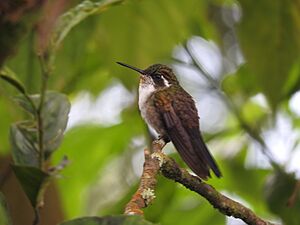Green-throated mountaingem facts for kids
Quick facts for kids Green-throated mountaingem |
|
|---|---|
 |
|
| male | |
 |
|
| female | |
| Conservation status | |
| Scientific classification | |
| Genus: |
Lampornis
|
| Species: |
viridipallens
|
| Synonyms | |
|
|
The green-throated mountaingem (Lampornis viridipallens) is a beautiful type of hummingbird. It's known for its bright colors and quick movements. You can find this special bird in parts of El Salvador, Guatemala, Honduras, and Mexico.
Contents
About This Hummingbird
The green-throated mountaingem is a kind of hummingbird. It's closely related to another bird called the green-breasted mountaingem. Scientists have divided the green-throated mountaingem into four slightly different groups, called subspecies:
- L. v. amadoni
- L. v. ovandensis
- L. v. viridipallens
- L. v. nubivagus
What Does It Look Like?
The green-throated mountaingem is about 11 to 12 centimeters (4.3 to 4.7 inches) long. It weighs around 5.4 grams (0.19 ounces), which is very light! Both male and female birds have a straight black beak. They also have a white stripe behind their eye and a slightly forked tail.
Male and Female Birds
Adult male green-throated mountaingems have green feathers on their upper body. Their lower back feathers are a bit bronzy. Their central tail feathers are black, and the others are pale gray. Their throat is white with bluish-green spots. Their chest is white, and their belly is grayish with green spots on the sides.
Adult females are similar to males but have bright emerald green upper parts. Their throat is plain white, without any spots. Young birds look like adult females, but their throat is a pale, creamy color.
Different Subspecies
Some subspecies have slight differences in their appearance. For example, L. v. amadoni is darker overall. L. v. nubivagus has dark green upper parts and a very bronzy lower back.
Where It Lives
The green-throated mountaingem lives in different areas depending on its subspecies:
- L. v. amadoni lives in the Sierra Atravesada area of southeastern Oaxaca, Mexico.
- L. v. ovandensis is found in Chiapas state in Mexico and northwestern Guatemala.
- L. v. viridipallens lives in eastern Guatemala, the very northern part of El Salvador, and western Honduras.
- L. v. nubivagus is found near the Santa Ana Volcano in western El Salvador.
This hummingbird likes to live inside and at the edges of humid evergreen and pine-oak forests. You can find it at elevations between 900 and 2,700 meters (2,950 to 8,860 feet) above sea level.
How It Behaves
Movement
The green-throated mountaingem does not travel far. It tends to stay in the same area all year round.
Feeding Habits
This hummingbird drinks nectar from flowers found at all levels of the forest. It also eats insects, which it catches by flying out and grabbing them in the air.
Reproduction and Life Cycle
Scientists know that green-throated mountaingems breed in March, April, June, and July. However, not much else is known about their breeding habits or how they raise their young.
Vocalization
The song of the green-throated mountaingem is a mix of squeaky notes and buzzy, gurgling sounds. It might sound like "tsee-tsee-glr-tsee-glr-tsee-glugluglugluglu-glr-glr-tsee." Its calls include a hard, buzzy "zzrrt," a short "tsik," and a high-pitched "see."
Conservation Status
The IUCN (International Union for Conservation of Nature) says the green-throated mountaingem is a species of "Least Concern." This means it's not currently in danger of disappearing. However, its population size is unknown and seems to be getting smaller.
Even though it's generally common and lives in some protected areas, its habitat is shrinking. This is because of deforestation, which is when forests are cut down. The bird does not seem to do well in areas changed by humans.


